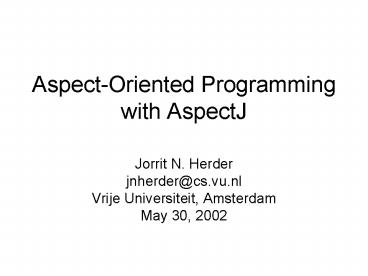AspectOriented Programming with AspectJ - PowerPoint PPT Presentation
1 / 14
Title:
AspectOriented Programming with AspectJ
Description:
... properties that can be cleanly encapsulated in a unit of ... AOP languages, like AspectJ, provide mechanisms to cleanly abstract from components & aspects ... – PowerPoint PPT presentation
Number of Views:49
Avg rating:3.0/5.0
Title: AspectOriented Programming with AspectJ
1
Aspect-Oriented Programmingwith AspectJ
- Jorrit N. Herder
- jnherder_at_cs.vu.nl
- Vrije Universiteit, Amsterdam
- May 30, 2002
2
Without AOP
3
With AOP
4
Talk Outline
- Different types of properties in software
- What aspect-oriented programming does
- An aspect-oriented extension to Java
- Seperating aspects and components
- Code example how synchronization policies can be
enforced with AOP - Overview of AOP and conclusion
5
Software properties (1/2)
- Components properties that can be cleanly
encapsulated in a unit of function or behavior,
like a procedure or object. - Aspects cross-cutting concerns that cannot be
captured in a functional decomposition
properties affecting the performance or semantics
of components.
6
Software properties (2/2)
- Components
- GUI elements
- Readers and writers
- Database
- Aspects
- Debugging
- Logging
- Synchronization
7
Aspect-Oriented Programming
- Separation of components and aspects
- This higher level of abstraction results in
- Better understanding of software because of high
level of abstraction - Easier development and maintenance because
tangling of code is prevented - Increased potential for reuse for both components
as well as aspects
8
AspectJ
- Is a general-purpose aspect-oriented extension to
Java, which is freely available from
http//www.aspectj.org/ - Java defines components as before
- by encapsulating data and behavior in objects
- AspectJ defines aspect modules
- by describing join points and behavior
9
Aspect Modules
- Identify join points
- Points in the execution of components where
aspects should be applied - E.g method invocation or object construction
- Describe behavior at join points
- Wrap join points with extra code just before or
just after execution - E.g. lock and unlock shared data
10
Example (1/2)
- Suppose multiple objects are concurrently working
on some shared data - Exclusive access needed for modification shared
data must be locked temporarily - Components readers, writers, and data
- Aspect the locking literally cross-cuts all
components that are working on the data
11
Example (2/2)
- Without AOP
- Every component that works on the shared data
must take care of the locking itself, leading to
tangled and complex code - With AOP
- The locking aspects and components are separated
by defining aspect modules, resulting in usual
benefits of modularization
12
- aspect ExclusiveAccess
- pointcut access() / three join points /
- call( void SharedData.setX(TypeX) )
- call( void SharedData.setY(TypeY) )
- call( void SharedData.setZ(TypeZ) )
- before() access() / behavior at joint
point / - acquireLock() / just before entering
/ - after() access() / behavior at joint
point / - releaseLock() / just after
returning /
13
Overview of AOP
14
Conclusion
- Todays programming languages have problems
capturing cross-cuttings - AOP languages, like AspectJ, provide mechanisms
to cleanly abstract from components aspects - Improved modularity allows simpler code that is
easier to develop and maintain, and that has
greater potential for reuse































